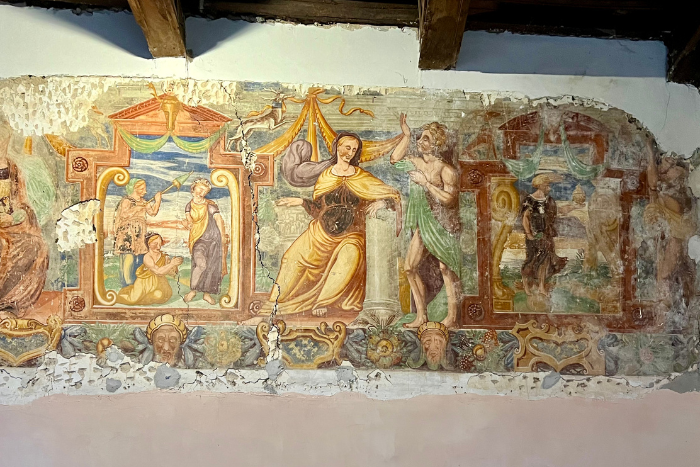Restored and opened about a month ago, the new Sala delle Sorti enriches the visit to the Torre Alfina Castle, arousing great interest and curiosity among visitors. It is a room decorated with allegorical frescoes that probably date back to the 1660s and transport observers into a world of mystery and divination.
Table of contents:
The Prestige of the House
The decoration of the Hall of Fortunes was commissioned by Monaldo Monaldeschi della Cervara, canon of St. Peter's and an illustrious member of the Monaldeschi family that ruled the castle and the village of Torre Alfina for centuries. The hand behind the execution of these works remains shrouded in mystery, although a possible influence of the Venetian painter Bartolomeo Cinzio, whom Monaldo Monaldeschi knew well thanks to his stay in Padua, is speculated. The intention of the decoration was to artistically represent the prestige and moral propriety of the Monaldeschi family.
The Allegories of the Hall of Fortunes
The frescoes in the Sala delle Sorti are inspired by the book Il Giardino dei Pensieri by Francesco Marcolini da Forlì, published in 1540. This is a fortune-telling and fortune-telling text in which human vices and virtues are depicted. In the castle hall, depictions of the Vices, such as Insidiousness, Lies and Discord, alternate with those of the Virtues, such as Faith, Charity and Temperance. This juxtaposition reflects the eternal struggle between good and evil, the predictability and unpredictability of fate. But while the Virtues are portrayed indoors, symbolising their constant presence and fundamental role in maintaining morality and good governance, the Vices are depicted immersed in outdoor settings. The final visual effect is the feeling that imaginary windows open up in the room, allowing one to observe the evil that lives outside the castle walls.
Vices and Virtues
The frieze runs along the walls of the room and presents a repetitive pattern: each allegorical depiction of vices is followed by a telamon (a male figure supporting the architecture of the frieze) and then a virtue. Thus Insidiousness, a woman fishing in a river flanked by a lynx, is followed by Charity; Discord, a woman holding a bellows from which smoke comes out, is followed by Temperance. Each representation is rich in symbolic detail, offering a comprehensive overview of the forces that shape human destiny and inviting viewers to reflect on the choices and actions that define one's path.
Historical Testimony
The restoration and opening of the Sala delle Sorti in the Torre Alfina Castle is an extraordinary addition to the historical and artistic heritage of the region. This new space enchants and inspires visitors, offering them the opportunity to immerse themselves in a world of symbolism and mystery. The allegorical frescoes of the Sorti e le Virtù represent an important historical and artistic testimony to our region and the people who lived here. the room invites reflection on the forces that influence human destiny and the importance of moral choices. The richness of detail and profound significance of these works testify to the skill and vision of its creators, leaving an indelible imprint on the memory of those privileged enough to visit.

